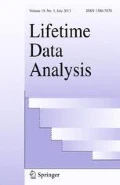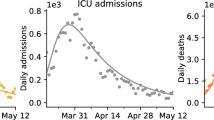Abstract
The aim of this work is to relate the theory of stochastic processes with the differential equations associated with multistate (compartment) models. We show that the Kolmogorov Forward Differential Equations can be used to derive a relation between the prevalence and the transition rates in the illness-death model. Then, we prove mathematical well-definedness and epidemiological meaningfulness of the prevalence of the disease. As an application, we derive the incidence of diabetes from a series of cross-sections.




Similar content being viewed by others
References
Andersen PK, Borgan Ø, Gill RD, Keiding N (1992) Statistical models based on counting processes. Springer, Berlin
Börsch-Supan A, Hank K, Jürges H (2005) A new comprehensive and international view on ageing: introducing the ‘survey of health, ageing and retirement in Europe’. Eur J Ageing 2(4):245–253. https://doi.org/10.1007/s10433-005-0014-9
Börsch-Supan A, Brandt M, Hunkler C, Kneip T, Korbmacher J, Malter F, Schaan B, Stuck S, Zuber S (2013) Data resource profile: the survey of health, ageing and retirement in Europe (SHARE). Int J Epidemiol 42:992–1001
Brinks R, Landwehr S (2014) Age-and time-dependent model of the prevalence of non-communicable diseases and application to dementia in Germany. Theor Popul Biol 92:62–68
Brinks R, Landwehr S (2015a) Change rates and prevalence of a dichotomous variable: simulations and applications. PLoS ONE 10(3):e0118955
Brinks R, Landwehr S (2015b) A new relation between prevalence and incidence of a chronic disease. Math Med Biol 32(4):425–435. https://doi.org/10.1093/imammb/dqu024
Brinks R, Landwehr S, Icks A, Koch M, Giani G (2013) Deriving age-specific incidence from prevalence with an ordinary differential equation. Stat Med 32(12):2070–2078
Brinks R, Bardenheier BH, Hoyer A, Lin J, Landwehr S, Gregg EW (2015a) Development and demonstration of a state model for the estimation of incidence of partly undetected chronic diseases. BMC Med Res Methodol 15(1):98. https://doi.org/10.1186/s12874-015-0094-y
Brinks R, Hoyer A, Kuss O, Rathmann W (2015b) Projected effect of increased active travel in German urban regions on the risk of type 2 diabetes. PLoS ONE. https://doi.org/10.1371/journal.pone.0122145
Brunet RC, Struchiner CJ (1999) A non-parametric method for the reconstruction of age-and time-dependent incidence from the prevalence data of irreversible diseases with differential mortality. Theor Popul Biol 56(1):76–90
Carstenson B, Kristensen JK, Ottosen P, Borch-Johnsen K (2008) The Danish National Diabetes Register: trends in incidence, prevalence and mortality. Diabetologia 51(12):2187–2196
Chubb MC, Jacobsen KH (2010) Mathematical modeling and the epidemiological research process. Eur J Epidemiol 25(1):13–19
Day NE, Breslow NE (1980) The analysis of case–control studies. International Agency for Research on Cancer, Lyon
DuChateau P, Zachmann D (2012) Applied partial differential equations. Dover books on mathematics. Dover Publications, Mineola
Egeberg A, Kristensen LE (2017) Impact of age and sex on the incidence and prevalence of psoriatic arthritis. Ann Rheum Dis. https://doi.org/10.1136/annrheumdis-2017-211980
Federal Statistical Office of Germany: Lifetables for Germany 1896–2009 (2011). https://www.destatis.de/
Fisz M (1963) Probability theory and mathematical statistics. Wiley, New York
Fix E, Neyman J (1951) A simple stochastic model of recovery, relapse, death and loss of patients. Hum Biol 23:205–241
Kalbfleisch J, Prentice R (2002) The statistical analysis of failure time data, 2nd edn. Wiley, New York
Kamke E (1983) Differentialgleichungen Lösungsmethoden und Lösungen. Teubner, Stuttgart
Keiding N (1991) Age-specific incidence and prevalence: a statistical perspective. J R Stat Soc A 154:371–412
Keiding N (2006) Event history analysis and the cross-section. Stat Med 25(14):2343–2364
Kermack WO, McKendrick AG (1927) A contribution to the mathematical theory of epidemics. Proc R Soc Lond A Math Phys Eng Sci 115:700–721
Lozano R, Naghavi M, Foreman K, Lim S, Shibuya K, Aboyans V, Abraham J, Adair T, Aggarwal R, Ahn SY (2013) Global and regional mortality from 235 causes of death for 20 age groups in 1990 and 2010: a systematic analysis for the global burden of disease study 2010. Lancet 380(9859):2095–2128
Mahiane GS, Ouifki R, Brand H, Delva W, Welte A (2012) A general hiv incidence inference scheme based on likelihood of individual level data and a population renewal equation. PLoS ONE 7(9):1–11. https://doi.org/10.1371/journal.pone.0044377
Muench H (1934) Derivation of rates from summation data by the catalytic curve. J Am Stat Assoc 29(185):25–38
Murray CJ, Lopez AD (1996) Global and regional descriptive epidemiology of disability: incidence, prevalence, health expectancies and years lived with disability. Glob Burd Dis 1:201–246
Ng M, Fleming T, Robinson M (2014) Global, regional, and national prevalence of overweight and obesity in children and adults during 1980–2013: a systematic analysis for the global burden of disease study 2013. Lancet 384(9945):766–781
Perera G, Pedersen L, Ansel D, Alexander M, Arrighi HM, Avillach P, Foskett N, Gini R, Gordon MF, Gungabissoon U et al. (2017) Dementia prevalence and incidence in a federation of European electronic health record databases: the European medical informatics framework resource. Alzheimers Dement. https://doi.org/10.1016/j.jalz.2017.06.2270.
Rait G, Walters K, Bottomley C, Petersen I, Iliffe S, Nazareth I (2010) Survival of people with clinical diagnosis of dementia in primary care: cohort study. BMJ 341:c3584
Reid WT (1972) Riccati differential equations. Elsevier, Amsterdam
Szklo M, Nieto J (2014) Epidemiology. Jones & Bartlett Learning, Burlington
Tamayo T, Brinks R, Hoyer A, Ku O, Rathmann W (2016) Prvalenz und Inzidenz von Diabetes mellitus in Deutschland. Dtsch Arzteblatt Int 113(11):177–182. https://doi.org/10.3238/arztebl.2016.0177
Termorshuizen F, Dorigo-Zetsma J, De Melker H, van den Hof S, Conyn-van Spaendonck M (2000) The prevalence of antibodies to hepatitis a virus and its determinants in the Netherlands: a population-based survey. Epidemiol Infect 124(03):459–466
Vos T, Barber RM, Bell B, Bertozzi-Villa A, Biryukov S, Bolliger I, Charlson F, Davis A, Degenhardt L, Dicker D (2015) Global, regional, and national incidence, prevalence, and years lived with disability for 301 acute and chronic diseases and injuries in 188 countries, 1990–2013: a systematic analysis for the global burden of disease study 2013. Lancet 386(9995):743
Walter W (1998) Ordinary differential equations. Graduate texts in mathematics. Springer, New York
Yang G (2013) Neyman, Markov processes and survival analysis. Lifetime Data Anal 19(3):393–411
Zachmanoglou E, Thoe D (1986) Introduction to partial differential equations with applications. Dover books on mathematics. Dover Publications, Mineola
Acknowledgements
This paper uses data from SHARE Waves 1, 2, 4 and 5. The SHARE data collection has been primarily funded by the European Commission through FP5 (QLK6-CT-2001-00360), FP6 (SHARE-I3: RII-CT-2006-062193, COMPARE: CIT5-CT-2005-028857, and FP7 (SHARE-PREP: Nr. 211909, SHARE-LEAP: Nr. 227822, SHARE M4: Nr. 261982). Additional funding from the German Ministry of Education and Research, the U.S. National Institute on Aging (U01_AG09740-13S2, P01_AG005842, P01_AG08291, P30_AG12815, R21_AG025169, Y1-AG-4553-01, IAG_BSR06-11, OGHA_04-064) and from various national funding sources is gratefully acknowledged (see www.share-project.org).
Author information
Authors and Affiliations
Corresponding author
Appendices
Appendix 1
From Eq. (5) it follows:
For brevity, we write \(\pi = \pi (\tau ), P_{0j} = P_{0j}(0, \tau ),\) and \(q_{jk} = q_{jk}(\tau ), ~j,k \in S\). Taking the derivative of \(\pi (\tau )\) with respect to \(\tau \) yields

In (*) the properties \(q_{11} = -q_{10} - q_{12}\) and \(q_{00} = -q_{01} - q_{02}\) have been used.
Appendix 2
We show that \(P_{00}(0, \tau ) + P_{01}(0, \tau ) > 0\) for all \(\tau \ge 0.\) It holds

Again, in (*) the properties \(q_{11} = -q_{10} - q_{12}\) and \(q_{00} = -q_{01} - q_{02}\) have been used.
For the moment, we assume that \(M := \sup _{\tau \ge 0} \{ q_{02}(\tau ), q_{12}(\tau ) \}\) is finite (\(M < \infty \)). With \(y(\tau ) := P_{00}(0, \tau ) + P_{01}(0, \tau )\) we have following differential inequality \(y^\prime \ge -M \, y\) with initial condition \(y(0) = 1.\) By defining \(h := y^\prime + M \,y \ge 0\) we find that
From \(h(\alpha ) \ge 0\) it follows that \(P_{00}(0, \tau ) + P_{01}(0, \tau ) \ge \exp \left( - M \, \tau \right) > 0 \text { for all } \tau \ge 0,\) which we wanted to prove.
The question arises under which condition we have \(M < \infty \). If \(q_{02}\) and \(q_{12}\) are continuous (which is reasonable for real diseases) and we apply the illness-death model up to a maximum age \(\omega \), when all people in the considered population have died, then we may conclude that \(M < \infty \).
Rights and permissions
About this article
Cite this article
Brinks, R., Hoyer, A. Illness-death model: statistical perspective and differential equations. Lifetime Data Anal 24, 743–754 (2018). https://doi.org/10.1007/s10985-018-9419-6
Received:
Accepted:
Published:
Issue Date:
DOI: https://doi.org/10.1007/s10985-018-9419-6




